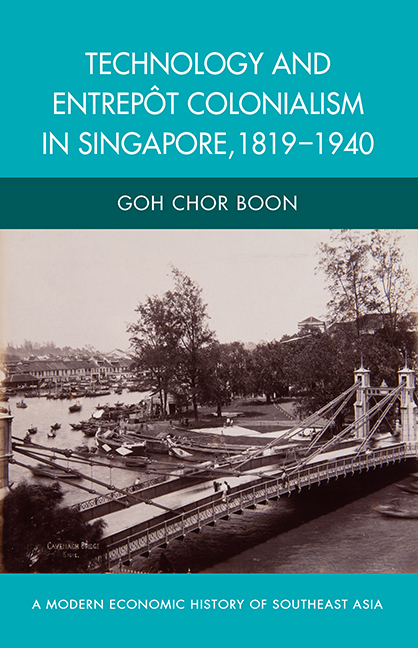Book contents
- Frontmatter
- Contents
- List of Figures and Tables
- Notes on Currency
- Introduction
- 1 Technology and the British Empire
- 2 Pioneers of Change: Entrepreneurs and Engineers
- 3 Maritime Technology and Development of the Port
- 4 Introducing Technological Systems
- 5 Sanitation and Public Health
- 6 Agriculture and Colonial Science
- 7 Food and Singapore Cold Storage
- 8 Politics of Imperial Education
- 9 Technology Transfer and Limited Industrial Growth
- Conclusion
- Bibliography
- Index
5 - Sanitation and Public Health
Published online by Cambridge University Press: 21 October 2015
- Frontmatter
- Contents
- List of Figures and Tables
- Notes on Currency
- Introduction
- 1 Technology and the British Empire
- 2 Pioneers of Change: Entrepreneurs and Engineers
- 3 Maritime Technology and Development of the Port
- 4 Introducing Technological Systems
- 5 Sanitation and Public Health
- 6 Agriculture and Colonial Science
- 7 Food and Singapore Cold Storage
- 8 Politics of Imperial Education
- 9 Technology Transfer and Limited Industrial Growth
- Conclusion
- Bibliography
- Index
Summary
Spreading industrialization in the West created new kinds of environmental issues. Early British and American factories spewed out smoke and were often condemned, as in Charles Dickens’ works, for their ugliness. Water quality was also a serious issue. The sheer growth of cities, which often had unprocessed sewage running into local rivers, and the growth of the chemical industry with its cost-saving impulse to dump industrial waste products into the same rivers, produced noticeable health hazards by the end of the nineteenth century. Active concern for public health in Britain dates from 1840s, though it was not until the 1870s that the application of science and technology to public health problems began to be significant. It was generally thought that the solution to public health problems depended on improved sanitation provided by large-scale civil engineering projects. Later, science and medicine began to exert an ever-increasing role, especially from the 1880s with the discoveries of Louis Pasteur and Robert Koch and the germ theory assumed importance in the fight against communicable diseases. As the nineteenth century progressed, technology and industrialization ushered in modern hygiene. Clean water, water closets, sewers, soap, together with better nutrition and improved housing, vastly reduced the incidence of infectious disease. Factories in the industrialized West mass produced cheap cotton underwear that was easy to clean.
While nineteenth century Singapore did not have industrial smokestacks to pollute the air and water, the rapidly growing colony and its population had to face up with environmental hazards that came with urbanization. The colony was shaping to be one of the many, to use the term favoured by urban historians, “walking cities” of the industrialized world. Since most inhabitants could not afford either the cost or the space required to keep a horse and carriage, they had to be able to walk to work or to work in their own homes. Businesses too had to be within walking distance of each other and this implied that as the colony grew, it became congested. More and more people had both to live and to work within the same relatively limited space. For most of the nineteenth century, building laws and by-laws to regulate town planning hardly existed.
- Type
- Chapter
- Information
- Technology and Entrepot Colonialism in Singapore, 1819–1940 , pp. 120 - 142Publisher: ISEAS–Yusof Ishak InstitutePrint publication year: 2013

